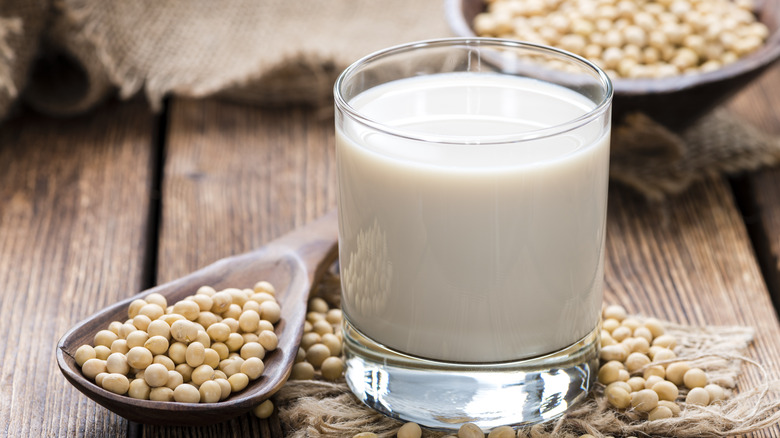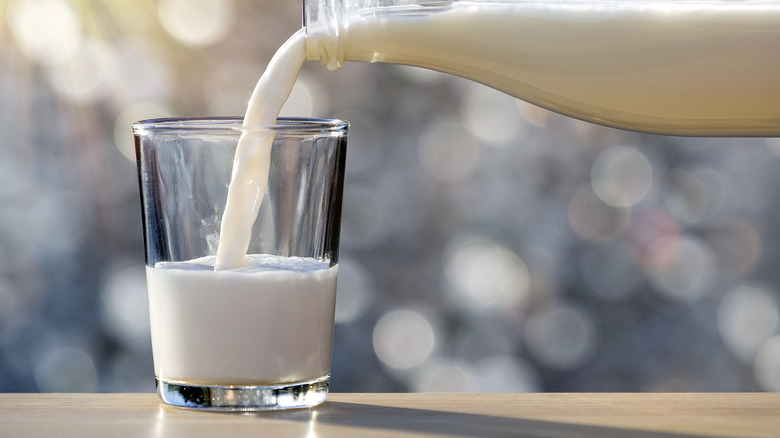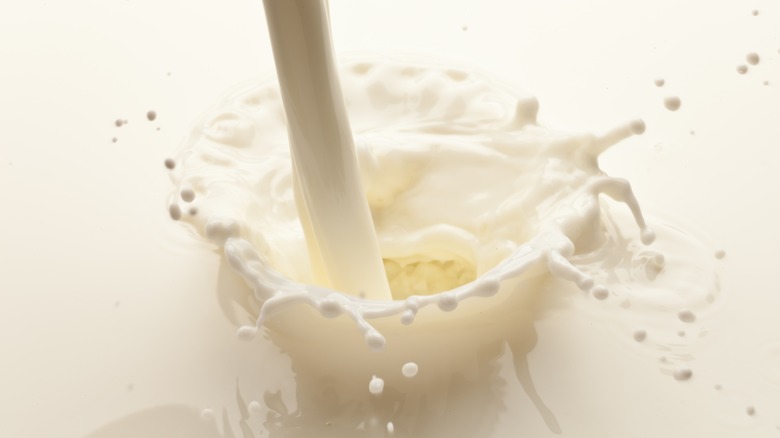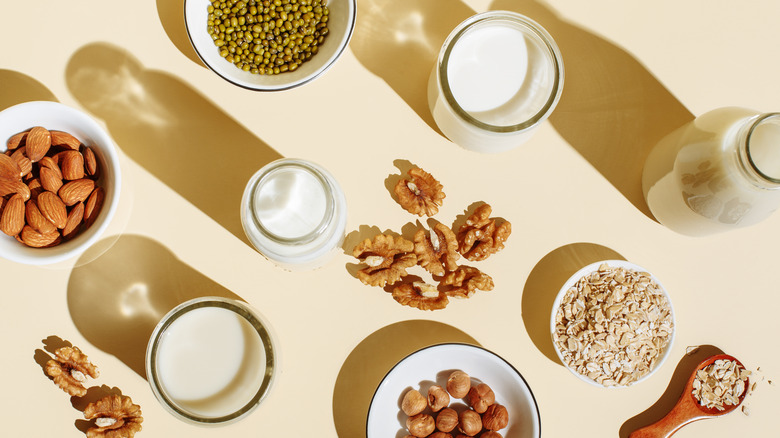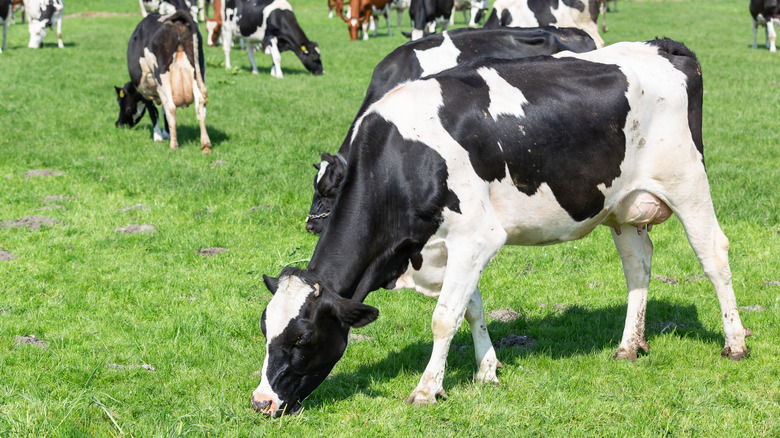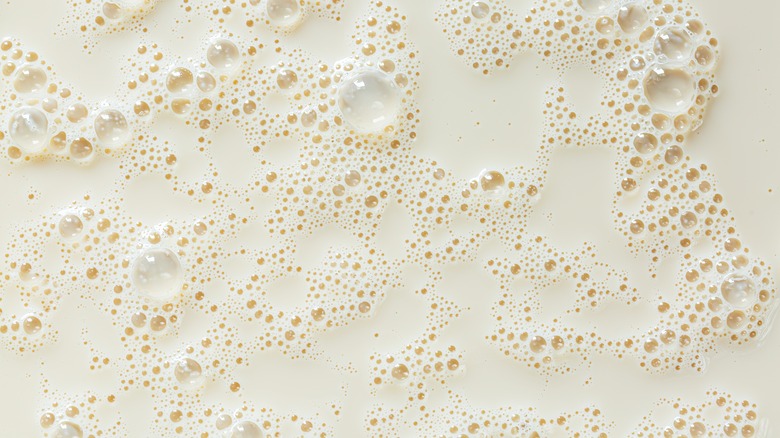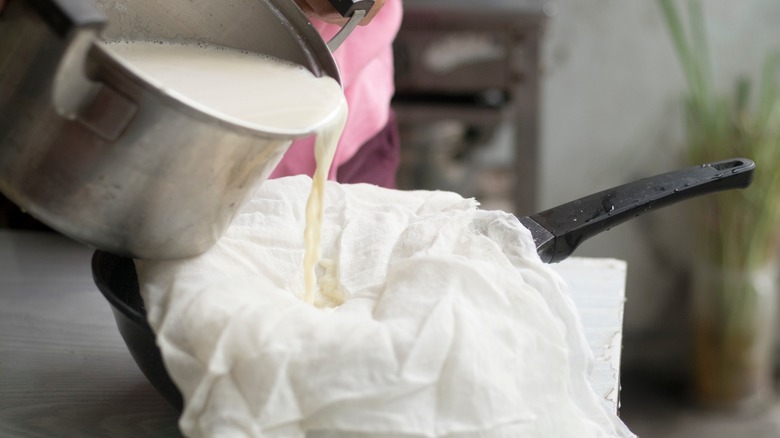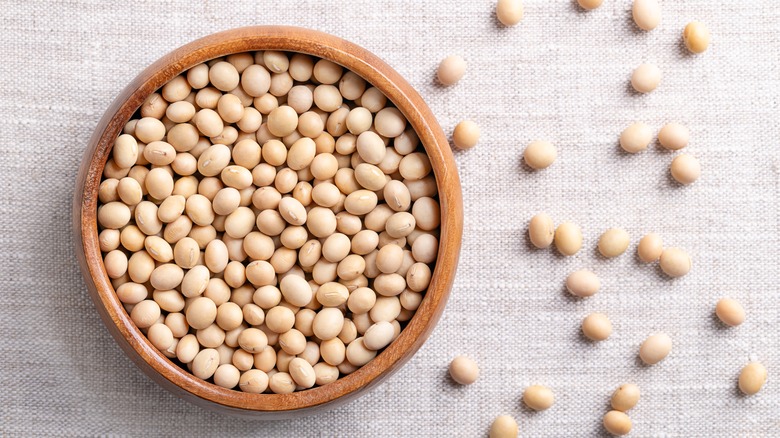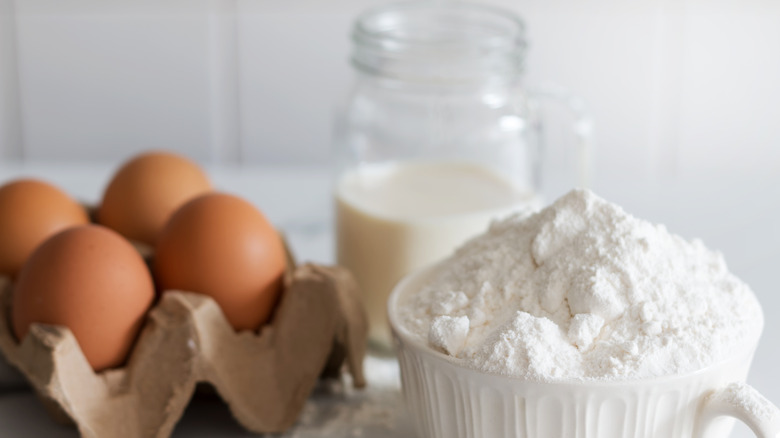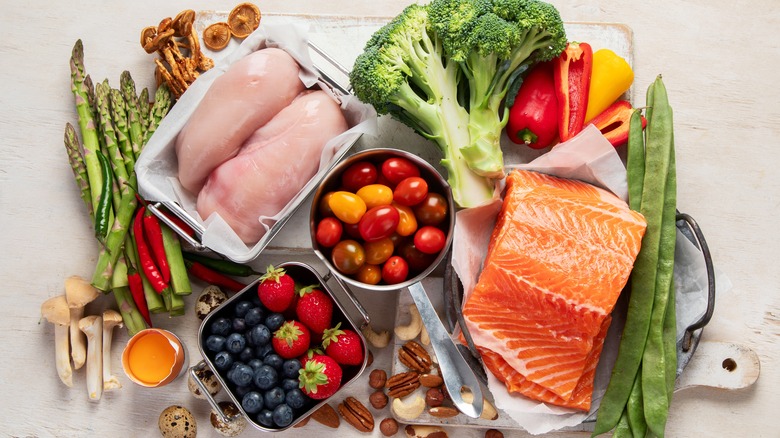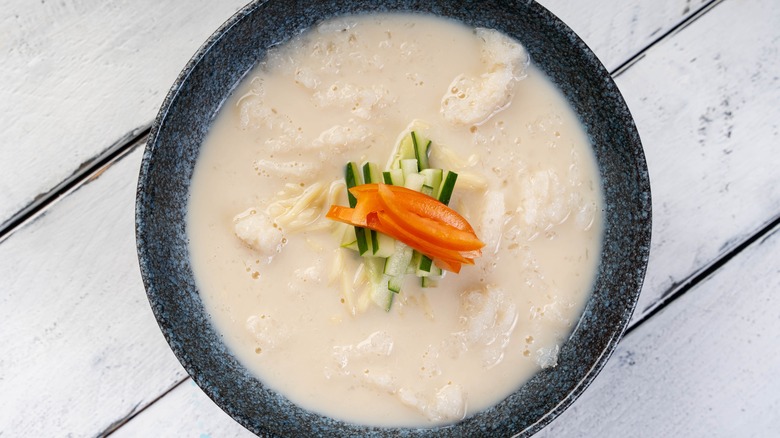12 Facts About Soy Milk You Need To Know About
Soy milk: the essential vegetarian beverage staple of the '90s and early 2000s. Or that's how it felt, at least, before a slew of different plant-based milks flooded the markets in the last decade, infiltrating our coffee shops and rendering dairy less relevant than ever. In the U.S., it seems like soy milk has gone from a crunchy-sounding novelty to a vegetarian standard to an often-forgotten relic of the health-focused past, relegated to the annals of barista history as oat and almond milks cast a long shadow over its legacy.
But there's more to soy milk than meets the eye. Its international history stretches millennia into the past, where it has served important roles in a variety of cultures' cuisines. And even if you drink the stuff every single day, whether with your coffee, in your cereal, or all on its own, there's a good chance that there's still a lot you don't know about the beverage.
Luckily, we're here to clean up some of the confusion. If you've ever been curious about soy milk's origins, its unique role in culinary history, or what it can do for your body (and the planet), then you're in the right place. These are facts about soy milk that you may not know about — yet.
Soy milk has its roots in East Asia
Soy milk is no new invention. It's been thought that soy — in many forms, including its milk — originated in China around 3,000 years ago. But now, evidence has shown that soy was traditionally produced in various areas around East Asia, including China, of course, but also Japan and Korea. In these countries, soy became and is still a staple in a variety of foods.
However, soy milk may not have played the most significant role in traditional Chinese diets. Oftentimes, it was not produced for its own sake but was rather a byproduct of tofu production, which cooks then attempted to use in other dishes. Sometimes, it would be served with breakfast, where it would be sweetened, salted, and eaten as a dipping sauce with pastries. When an American physician named Harry W. Miller visited China and Japan and became acquainted with soy milk, he saw its potential in the American market.
It was used as a replacement for dairy milk during World Wars I and II
It's no secret that World Wars I and II were not easy for the people who had to live through them. In the United States and other parts of the world, many countries' food supplies were being sent abroad to feed hungry soldiers on the battlefield. This left many without access to the foods they were accustomed to, necessitating that they look for suitable alternatives. In the U.S., dairy was in short supply during wartime, so where did thirsty families turn? To soy milk, of course.
In this way, soy milk didn't exactly serve the same function as it did in Asian countries, where it was treated as a specific ingredient in its own right. Rather, it was viewed as a substitute for food that wasn't accessible because of the particular circumstances of wartime. Of course, this didn't exactly lend the most flattering sheen to the beverage, which was then, in many cases, viewed as a less desirable alternative than dairy milk. Perhaps some of Americans' reticence to fully embrace soy milk today is a vestige from those days of lack.
Its popularity has waned as other non-dairy milks become more available
When you go to the trendy coffee shop in your neighborhood (or even just a standard Dunkin', these days), you may notice that there are a slew of non-dairy milks to choose from. Oat, almond, cashew, even macadamia — the choices are seemingly endless. Although many of these places still offer soy milk, it doesn't seem to be advertised with quite the same verve as, say, oat milk. (When was the last time you saw an ad specifically for a soy milk latte instead of an oak milk latte? Exactly.)
Well, you're not wrong. Soy milk has always experienced barriers to acceptance in the U.S., but with so many non-dairy milks now flooding the market, it's become less and less popular. For some people, of course, it all comes down to a preference of flavor. Oat milk, with its more neutral flavor and creamy texture, may actually be more appealing to many coffee drinkers and cereal eaters. But some of soy milk's waning popularity likely has to do with peoples' perceptions around the health consequences of eating soy.
Soy milk's water footprint is smaller than that of dairy milk
There is no one way to measure a specific food's level of environmental sustainability. There are so many different factors that come into play: the inputs needed to produce that product, how it's shipped and transported, and what happens to the packaging waste after the product has been consumed. Therefore, it's important to drill down to specific aspects of sustainability to gain a greater understanding of the environmental impact of certain ingredients, like soy milk.
And when it comes to the water footprint of different kinds of milk, soy milk is way, way more sustainable than its dairy counterpart. You need about 67 gallons of water to produce a single glass of dairy milk. On the other hand, to produce a glass of soy milk, you're only looking at about 18 gallons of water. Therefore, you could make more than three glasses of soy milk for every one glass of dairy milk you produce. Sure, there are other factors to consider on the sustainability front. But if you're worried about excess water consumption (which we should all be!), then you might just find that soy milk starts to taste a lot better — at least to your moral compass.
Many believe that fresh soy milk tastes way better than store-bought
In many parts of the United States, when you buy soy milk from a mainstream, big-box grocery store, you're not exactly getting the freshest version of the ingredient available. Rather, it's often spiked with additives and sugar. You may not think that makes much of a big difference, but many disagree. In fact, for many people who have grown up with homemade soy milk, which is common in many Asian families, commercial, store-bought soy milk doesn't even come close to the real thing.
Apparently, freshly made soy milk is actually quite rich and creamy, similar to fresh cow's milk. The flavor is said to be somewhat similar to tofu, which is a rather nondescript flavor itself, but the texture is supposed to be what truly shines: Creamy, rich, and velvety, the thickness is said to coat your tongue as it goes down.
If you love the soy milk you pick up at your local grocery store, nobody's telling you not to have it. In fact, if that's what you're familiar with, you might even prize it over the fresh version. But if you already enjoy soy milk and you want to get a taste of the stuff so many people drool over, you have to find some of the freshly made variety.
Henry Ford helped soy milk go mainstream
You may not think that cars and soy milk have much in common, but you'd be wrong. That's because Henry Ford (yes, the Henry Ford of Ford fame) actually played a significant role in making soy milk a somewhat mainstream beverage in the United States. The businessman he was, he saw soy's potential not only as a foodstuff but also as an industrial resource. He thought he could use soybean oil for use in his factories to make cars. Sounds delicious, right? Ford thought that big agriculture and big business could reinforce each other and prop each other up. Well, we see how well that's going!
According to his capitalist ethos, he saw cows as a type of machine — an inefficient machine, in fact — and he thought that soy milk could replace the work they did to produce sustenance for humans. He was right about one thing, though: Instead of feeding cows soy so the cows can produce milk, it's more efficient (and better for the environment) to just take that soy and turn it into milk itself.
Although aspects of these ideas are undeniably problematic, Ford saw the potential of soybeans before most. And considering that soy is the second-most planted monocrop in the U.S., second only to corn, it seems like he was right.
It's easy to make your own soy milk at home
So, you've heard about how good fresh soy milk is and want to try it for yourself? Sure, you could spend hours wandering around town, visiting Asian and vegetarian markets that maybe, somehow, stock it (but actually probably don't), or you could just learn how to make it yourself at home. We know what you're thinking: Don't you need a bunch of special equipment, not to mention a culinary degree, to make plant-based milk in the comfort of your own kitchen? Actually, no — making your own soy milk is a surprisingly easy task if you just know what to do.
First, you'll start off by soaking the soybeans with some water and then blending them in a blender. Don't worry, you don't need any special blender here. The one you use for your morning smoothies will do the trick. Then, you'll put the mixture in the pot and cook it down until it foams, making sure it doesn't burn on the bottom of the pot. After that, you can strain the mixture with a muslin-lined colander (don't be afraid to really squeeze the beans to get all the milk out) and put your soy milk in the fridge. After it cools for a few hours, you'll have fresh soy milk that you can enjoy on its own or in coffee, cereal, or any other recipe that calls for the ingredient. Happy sipping!
Soy milk isn't really bad for men, despite sexist claims
Maybe you've heard the term "soy boy" to describe a man who doesn't fit into society's strict views of gender roles. The name isn't just a coincidence — there are a lot of myths floating around about the toll soy milk, along with other soy-based products, can have on male hormones. This is because soy contains an estrogen-like substance known as isoflavones. And although isoflavones can mimic estrogen in the body, numerous studies have indicated that it doesn't negatively affect male hormone levels. And considering that soy can be good for both heart health and build muscle mass, it likely plays a beneficial role in many men's diets.
But we as a culture may still have a long way to go to convince some men that they needn't worry about the effect soy products have on their testosterone levels. The association between assumed "vegetarian food" and femininity has been well documented, notably by vegan feminist scholar Carol J. Adams in her book "The Sexual Politics of Meat."
Soy milk is a complete protein
So, you're watching your protein intake. That's great! But if you're following a plant-based diet — or you just want to cut down on the amount of animal protein you're eating — it can be tricky to find foods that are complete proteins, meaning that they contain all nine essential amino acids the body needs for daily functioning. However, there are a few different plant foods that do contain all those amino acids you need, and they're great to add to your diet whenever possible, regardless of whether you follow a plant-based diet or not.
One of those ingredients, of course, is soy milk. Since it's free of cholesterol and trans fats, it can be incorporated into a healthy diet for people who have specific dietary needs. Plus, soy milk is especially useful in contexts of poverty or food insecurity, when it might otherwise be difficult to meet daily protein needs. Soy milk, of course, isn't the only way to get more protein into your diet, but it's a great option for those who either can't or don't want to eat too many animal products.
It's the best non-dairy milk for baking
Whether you don't want to use dairy products because you're following a vegan diet, you're lactose intolerant, or you just want to cut down on the number of animal products you use in your cooking, it's usually easy to swap out dairy milk for plant milk in most recipes. But when it comes to baking, it's a whole different story. If you're looking for the ideal plant-based milk to use in all of your favorite baked goods, soy milk may just be your best option.
One of the reasons why soy milk is such a good option for baking is simply because it doesn't have much flavor to it that can compete with the other ingredients in your recipe. Coconut milk, for example, has an explicitly coconut-like flavor to it, which can clash with other elements in some recipes. Additionally, it has plenty of protein, compared to alternatives like oat milk, which makes it give baked goods that density you're looking for in a lot of cases. And since the texture is similar to that of dairy milk, it's an easy swap that doesn't require much tricky math.
Soy milk is keto friendly
When you're starting a new diet, it can be difficult to figure out what foods you can and can't eat. Especially in the beginning of following a diet, that can lead to a lot of slip-ups that can stall your progress or, in the worst cases, actually make you sick. That's why it's important to make sure that your favorite foods line up with your diet of choice. And if you're following a keto diet and already love soy milk, well, you're in luck.
Plant-based milks made out of carbohydrate-rich foods, like oats and rice, for example, are not the best option for a keto diet. Instead, you can use soy milk for an easy swap. Not only is it keto-friendly, meaning it fits into your diet, but it's also generally just regarded as the healthiest dairy milk swap out there, largely because of its high protein content. That being said, you'll want to make sure you're avoiding soy milk that contains added sugar, so make sure you pay close attention to the nutrition information. If you don't like the flavor of soy milk on its own, you can simply use it in coffee, cereal, and baked goods instead of drinking it plain.
It's an essential ingredient in a delicious cold Korean soup
Sometimes, you just get an intense craving for soup. But when that craving arrives in the midst of a hot summer, the idea of boiling a bunch of carrots and potatoes on your stove for hours may not sound that appealing — and that's before you even take a bite. Luckily, there are plenty of cold soup recipes out there from myriad cuisines, but one of our favorites has to be Korean kongguksu, which translates to "soybean noodles." It's often enjoyed during the hot summer months in Korea, as it has a lovely cooling, refreshing effect.
If you want to make kongguksu yourself, you'll want to start with fresh, homemade soy milk — and yes, in this case, you'll definitely want to make your own. Q-textured noodles then bathe in the soy milk, creating a texturally rich and undeniably delicious soup that you'll surely want to slurp down all summer long.
